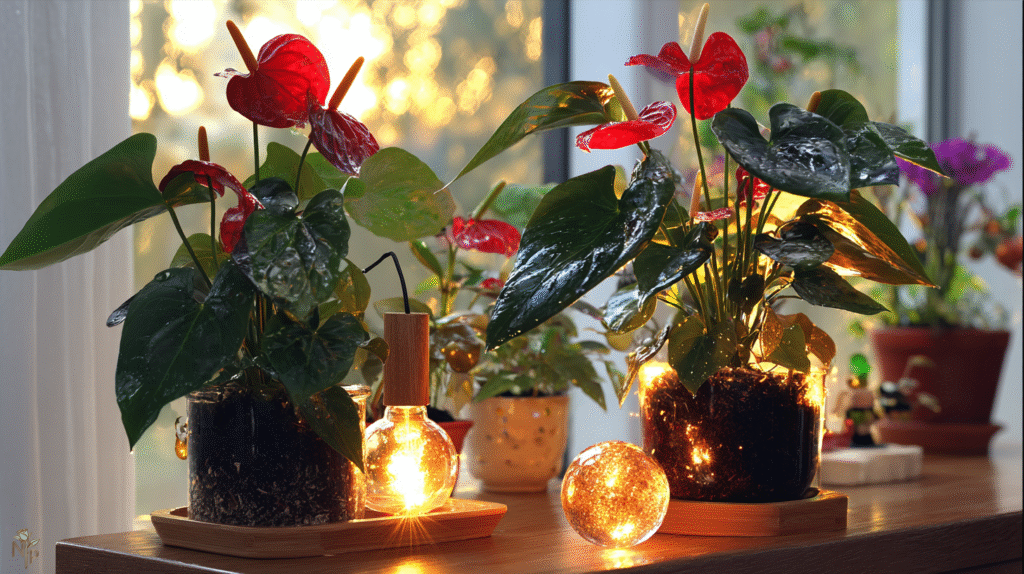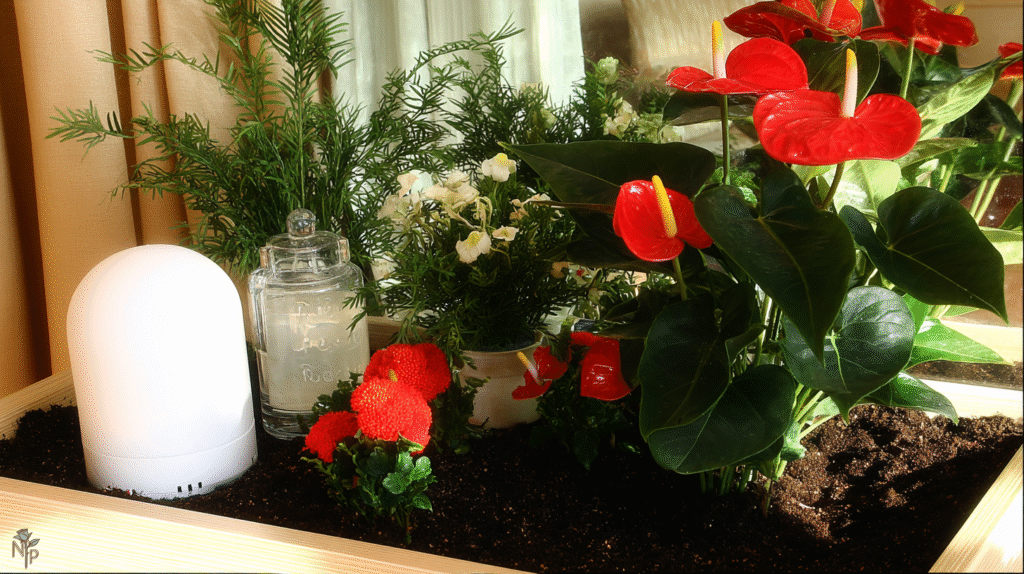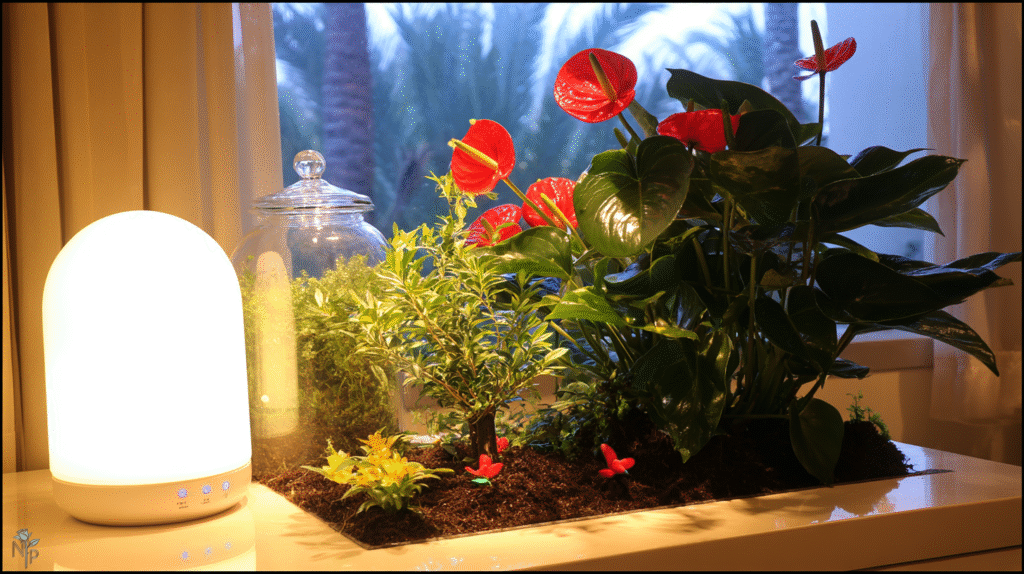Got an anthurium for my birthday last year. Big red waxy flowers, shiny leaves, came with a tag saying “blooms for months!” Four weeks later, the flowers turned green, then brown, then fell off. Haven’t seen a bloom since. That was 14 months ago.
Sound familiar? Yeah, turns out those gift anthuriums from the grocery store are pumped full of bloom-boosting hormones in greenhouses. Once they’re in your house, they go on strike. My mom’s had one for three years – zero blooms. My coworker’s Valentine’s anthurium? Bloomed once then became a green plant with commitment issues.
But here’s the thing – I finally cracked the code. My birthday anthurium is on its fourth round of blooms this year. My rescue anthurium from Facebook Marketplace (got it for $5 because “it won’t bloom”) has three flowers right now. After killing the blooms on four different anthuriums, I finally figured out what they actually want versus what the care tag claims.

Understanding Anthurium Blooming Cycles
Why Store-Bought Anthuriums Stop Blooming
Those perfect grocery store anthuriums are basically plant athletes on steroids. They’re grown in perfect greenhouse conditions – 80°F, 80% humidity, exact fertilizer ratios, and probably growth hormones. Your house? Not that.
When I learned this, I stopped feeling like a failure. My apartment is 68°F in winter with 30% humidity. Of course it stopped blooming. It went from a tropical spa to plant jail.
The Natural Blooming Pattern
Real anthuriums in normal homes bloom in cycles, not constantly. Mine blooms for 2-3 months, rests for 2 months, then blooms again. This is normal. That “blooms year-round” tag is technically true but misleading as hell.
First time mine went dormant, I panic-fertilized it. Made things worse. Now I know: no blooms for 2-3 months is normal resting, not death.
Signs a Bloom Cycle Is Starting
Took me forever to recognize these:
- Thick stem (called a spadix) emerging from leaf joint
- Stems are thicker and grow straight up (leaf stems curve)
- Tiny bump forms that becomes the spathe (the red part)
- Takes 6-8 weeks from bump to full bloom
Once you know what to look for, it’s exciting watching them develop. Like plant Christmas every few months.
Light: The Make-or-Break Factor
The Bright Indirect Sweet Spot
“Bright indirect light” killed my first anthurium’s blooms. I had it 6 feet from a north window thinking that was “bright.” It was basically a cave. Moved it 2 feet from an east window – bloomed within two months.
Here’s what actually works:
- East window: 1-3 feet away, perfect morning light
- South window: 4-6 feet back or with sheer curtain
- West window: Only with filtering, afternoon sun is murder
- North window: Directly in it or forget blooms
Bought a light meter after killing blooms on plant #3. Anthuriums want 1000-2000 foot candles for blooming. My “bright” spot was 200 FC. No wonder nothing happened.
The Direct Sun Disaster
“Some direct sun encourages blooming” said the internet. Gave mine 2 hours of afternoon sun. Leaves burned, flowers turned brown, newest bloom literally cooked. Took 6 months to recover.
Morning sun only, if any. Even then, watch for:
- Bleached leaves (too much light)
- Brown patches (sunburn)
- Flowers fading quickly (heat stress)
Grow Light Success Story
My bathroom anthurium gets a $25 LED grow light because the frosted window isn’t enough. 10 hours daily, positioned 12 inches above. It’s bloomed three times this year. The window-only one? Twice.
Watering for Maximum Blooms
The Moisture Balance
Anthuriums want to be moist but not wet. Helpful, right? Took me months to figure out this actually means:
- Top inch dry, rest slightly damp
- Never bone dry (stops blooming)
- Never soggy (root rot, death)
I check every 3-4 days, water maybe weekly in summer, every 10 days in winter. But here’s the secret: consistent moisture = more blooms. The feast-or-famine watering I was doing stressed it too much to bloom.
Water Quality Impact on Blooming
My tap water has so much chlorine you can smell it. Switched to filtered water and my anthurium produced a new bloom within a month. Coincidence? Maybe. But it’s had consistent blooms since switching.
If your anthurium has brown leaf tips but won’t bloom, try filtered water. Can’t hurt, might help.
The Humidity Hack for Blooms
Anthuriums want 60-80% humidity to bloom well. My apartment in winter: 30%. No wonder they wouldn’t bloom.
Solutions that actually worked:
- Humidifier set to 60% (blooms increased dramatically)
- Bathroom placement if there’s good light
- Pebble tray (helps a little, not enough alone)
- Grouping plants together (creates microclimate)
Misting doesn’t work. Just makes leaves wet and causes spots.

Fertilizing for Flowers, Not Just Leaves
The High Phosphorus Secret
Used regular houseplant fertilizer (balanced 10-10-10) for a year. Tons of leaves, zero blooms. Switched to high phosphorus (10-30-20) – new bloom within 6 weeks.
Phosphorus (middle number) promotes blooming. Nitrogen (first number) promotes leaves. Was basically telling my plant to make leaves, not flowers. No wonder it listened.
Feeding Schedule That Works
Growing season (March-September):
- Every 2 weeks with quarter-strength high-phosphorus fertilizer
- Once a month with Epsom salt (1 tbsp per gallon) for magnesium
Dormant season (October-February):
- Once monthly, half the growing season strength
- Skip if it’s actively blooming
Overfertilized once thinking more food = more blooms. Got fertilizer burn and no blooms for 4 months.
The Coffee Ground Experiment
Read that coffee grounds increase acidity and promote blooming. Dumped used grounds on soil. Got fungus gnats and mold. Don’t do this.
Now I make “coffee tea” – soak used grounds in water for 24 hours, strain, dilute by half, use monthly. Maybe helps? Doesn’t hurt, doesn’t attract bugs.
Environmental Tricks for More Blooms
Temperature for Triggering Blooms
Anthuriums bloom more with temperature variation. Constant 72°F = fewer blooms. Letting it experience 65°F nights and 75°F days = more blooms.
Started turning heat down at night (saves money too). Anthurium started blooming every 3 months instead of twice a year.
The Stress Factor
Slight stress triggers blooming. Not death stress, just “better reproduce” stress. Being slightly root-bound encourages blooming. Repotted into huge pot = no blooms for 6 months. Kept another slightly tight = blooms constantly.
Also, letting it dry out slightly between waterings (not bone dry) seems to trigger blooming. Too comfortable = lazy plant.
Air Circulation Importance
Stagnant air = fewer blooms and potential fungal issues. Small fan running on low, not pointed directly at plant, increased blooming and prevented the weird spots mine used to get.
Maintaining Existing Blooms
Why Blooms Turn Green
Those red “flowers” turning green? They’re aging. It’s normal. The spathe (red part) is actually a modified leaf, so it turns green as it ages. Not dying, just old.
Mine stay red for 6-8 weeks, then slowly green over 2-3 weeks. Still photosynthesizing, still helping the plant.
When to Remove Old Blooms
Don’t cut blooms when they turn green – they’re still feeding the plant. Wait until:
- Stem starts yellowing
- Spathe turns brown
- Whole thing looks actually dead
Cut at the base with clean scissors. Leaving dead blooms on diverts energy from new blooms.
Extending Bloom Life
Keep blooms away from:
- Direct sun (fades color quickly)
- Heating vents (dries them out)
- Cold windows (shortens lifespan)
- Fruit bowls (ethylene gas ages them)
My kitchen anthurium’s blooms lasted 4 weeks. Moved it away from the banana bowl – next blooms lasted 8 weeks.
My Current Blooming Success Setup
The Champion Plant
- 3 feet from east window
- Humidifier keeping 55-60% humidity
- High-phosphorus fertilizer biweekly
- 5-inch pot (slightly root-bound)
- Produces 4-5 blooms yearly
The Bathroom Bloomer
- North window with grow light supplement
- Natural humidity from showers
- Same fertilizer schedule
- Blooms smaller but more frequent
- 6-7 blooms yearly
The Recovery Project
- Rescued non-bloomer from Facebook
- Moved to bright light, proper fertilizer
- First bloom took 4 months
- Now blooms every 3-4 months
- Proof that “non-bloomers” can be fixed

The Reality Check
Getting gift anthuriums to rebloom isn’t automatic. They need:
- Way more light than you think (1000+ FC)
- Consistent moisture, never extremes
- High phosphorus fertilizer regularly
- Humidity above 50% ideally
- Temperature variation day/night
- Patience between bloom cycles
My anthuriums don’t bloom constantly like the greenhouse ones. But they do bloom regularly, the flowers last 2-3 months, and I get the satisfaction of not killing another gift plant.
Just remember: that perfect store anthurium was grown in perfect conditions you can’t replicate. But you can create good-enough conditions for regular blooming. Lower your expectations from “constant blooms” to “blooms several times a year” and you’ll actually enjoy the plant instead of feeling like a failure.
Plus, when you finally get that first rebloom after months of trying? Better feeling than the original gift. Trust me.






